Top 7 Python Frameworks: Which One You Should Choose

Top 7 Python Frameworks: Which One You Should Choose
Python is widely regarded as a relatively accessible programming languages out there. Plus, many development frameworks are available for Python that further enable developers to take on projects across a range of complexities while using the language.
Python frameworks make your life easier by providing a structure for application development, automating the implementation of standard solutions, and significantly reducing development time. This way, you can focus on the application logic instead of wasting your time and energy on trivial routine elements.
However, choosing which Python web development framework for your project is an exciting debate. Different teams have different responses, and it will leave you confused.
We have listed the seven most popular python web frameworks in 2022 and beyond to make it easier.
7 Best Python Frameworks for Your Project
Here are our top picks for top python frameworks:
Looking for assistance with Python development? Connect with a specialized Python development company on The Manifest.
1. Flask
Flask is a leading Python framework inspired by the Sinatra Ruby framework, and it relies on the Werkzeug WSGI toolkit and Jinja2 template. The idea behind Flask is to develop a strong web application base where you can use any extension you need.
Flask is designed for open-ended applications and is suited for small and easy projects. Companies like LinkedIn and Pinterest use it.
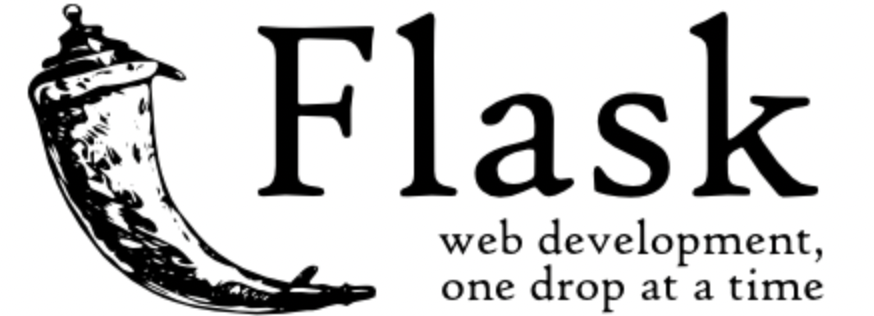
Source: Flask
Key Features of Flask
- A Built-in development server and a fast debugger
- Integrated support for unit testing
- Ability to plug in any ORM
- HTTP request handling
- RESTful request dispatching
- Unicode-based
- Secure cookies support (client-side sessions)
Pros of Flask
- The lightweight, modular design makes Flask easily adaptable to developers’ needs.
- Flask allows you to scale the server to handle increased load/traffic.
- You can quickly get started with Flask and use it even with basic knowledge of Python.
- You can enhance the efficiency, testing, and performance of your web app by creating multiple Flask applications using the modular code of Flask.
Cons of Flask
- Since Flask is lightweight, it has limited tools and requires you to add extensions manually.
- The modular nature of Flask may make it difficult for developers joining in the middle to get the hang of the project.
- Maintenance costs shoot up as your project progresses further.
2. Django
Django is a free, open-source Python framework that lets developers develop high-quality web apps. It has over 12,000 known projects and is one of the most famous Python frameworks for API and web application development.
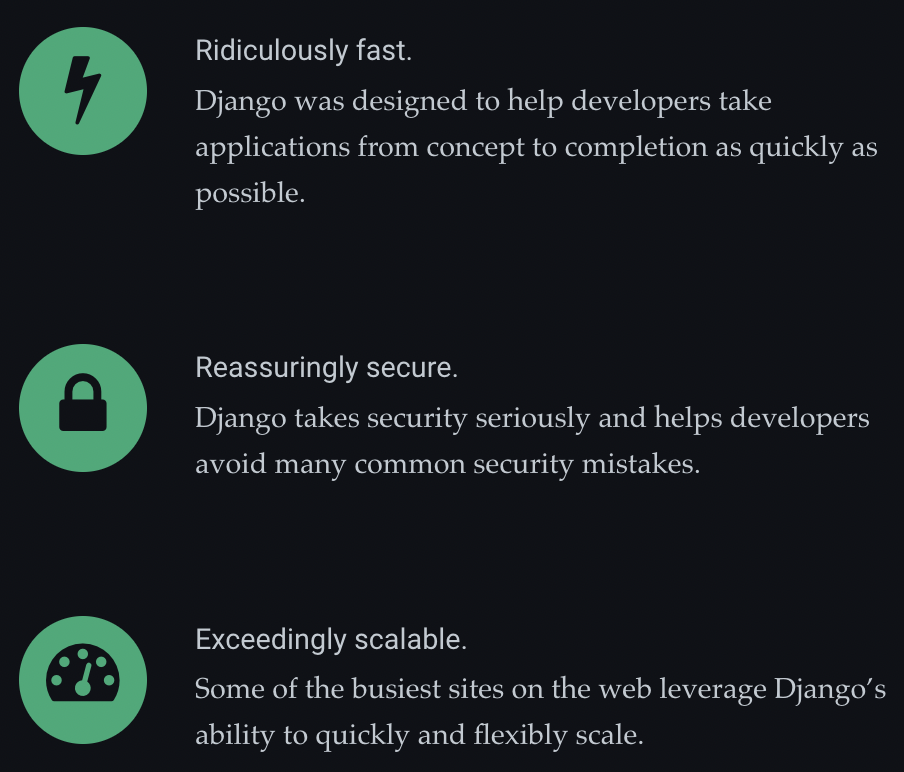
Source: Django
Features of Django
- A colossal collection of libraries
- Scalable and versatile
- Extensive documentation and active community support
- Built-in templates, attack protection, form validation, and ORM (Object-relational mapper)
- Object-oriented programming language database that provides the best data storage and recovery
Benefits of Django
- Django can save you a lot of time by letting you import packages for adding functionalities instead of writing code from scratch.
- You can leverage the intelligent development capabilities of Django to develop applications that use IoT, AI, and machine learning.
- Django can help you create dynamic, scalable websites that withstand heavy traffic.
- You can use the syntax rule of Python in Django to write clean, readable, and maintainable code.
- There are minimum chances of security loopholes in Django as it offers complete protection against SQL injection and cross-site request forgery attacks.
Drawbacks of Django
- Since Django doesn’t have conventions, you have to define everything manually. It can slow down the development process.
- You can’t use their file structure because of the monolithic nature of Django.
- Django has a substantial learning curve and is not ideal if you’re a beginner.
3. CherryPy
CherryPy is exceptionally quick, stable, and can run on any working framework supporting Python. With this open-source Python web development framework, you can do everything that a web framework is capable of, such as taking care of sessions, file uploads, static, cookies, etc.
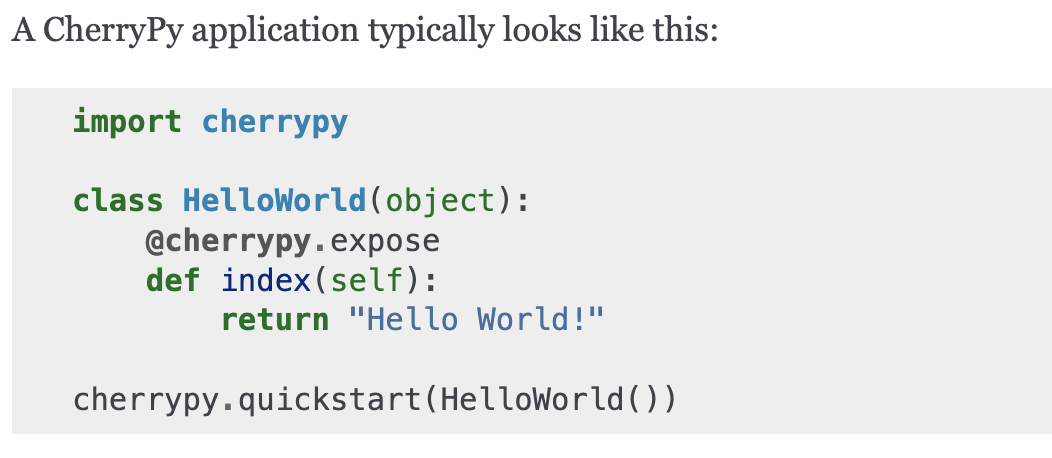
Source: CherryPy
Key Features of CherryPy
- Built-in tools for encoding, sessions, caching, authentication, static content, and many more
- A powerful configuration system for developers and deployers alike
- A consistent, HTTP/1.1-compliant, WSGI thread-pooled webserver
- Built-in profiling, coverage, and testing support
- Easy to run various HTTP servers (for example, on multiple ports) at once
Pros of CherryPy
- CherryPy doesn’t force developers to stick to a particular structure, making it flexible.
- With CherryPy, you can easily create web services like RESTful web service (RWS), WSDL, SOAP, etc.
- CherryPy is cost-effective as compared to other Python web development frameworks.
Cons of CherryPy
- CherryPy lacks comprehensive documentation, making it challenging to work with if you’re a beginner.
4. Pyramid
Pyramid is an open-source Python web development framework for creating small and large applications.
With Pyramid, you can scale a small project or start a big one immediately, and the python framework is best for stakeholders who prefer minimalism.
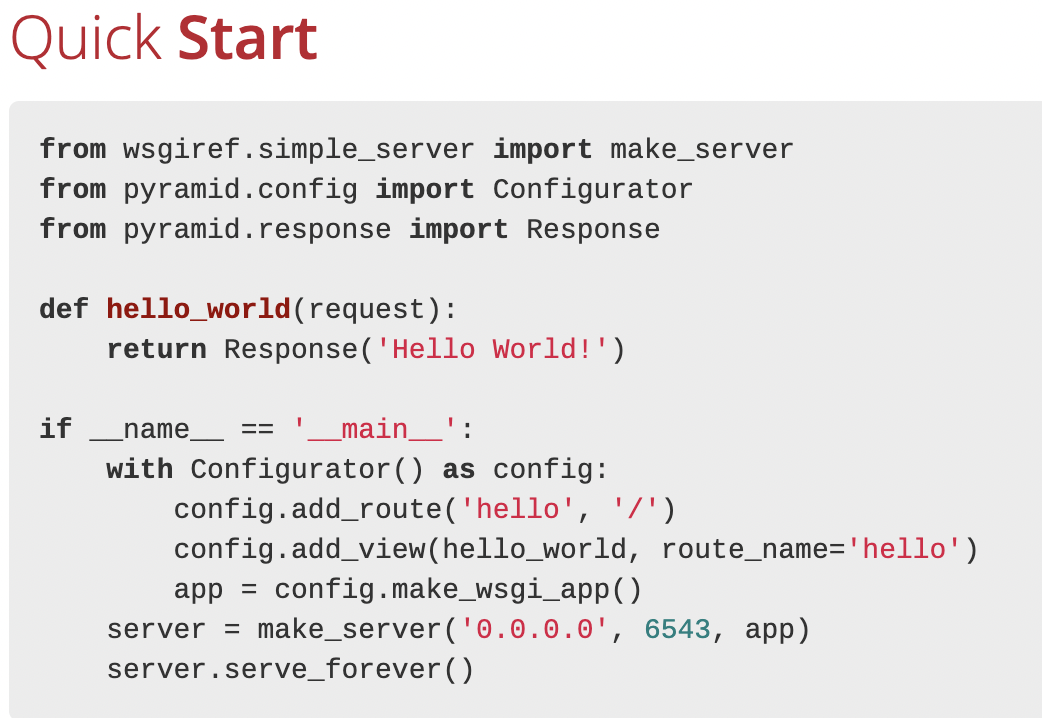
Source: Pyramid
Features of Pyramid
- Flexible authentication and approval.
- Templating and asset specifications
- HTML structure validation and generation
- Pyramid offers testing, support, and comprehensive data documentation.
Advantages of Pyramid
- XHR views and decorators of Pyramid make it easy to send Ajax requests
- Pyramid supports the SQLAlchemy database. It is good news for developers who can use it to work with complex projects.
- The flexible nature of the Pyramid framework makes it easy to replace components.
Drawbacks of Pyramid
- You can’t build complex web apps without a deep understanding of Pyramid.
- SQLAlchemy is not necessary or even useless in simple projects.
5. Web2Py
Web2Py is a full-stack python framework as you can quickly scale it through web-based integrated development. It is also a cross-platform framework that supports Windows, Unix/Linux, Mac, Google App Engine, and several other platforms. It also has built-in systems for issuing user tickets in case of any error.
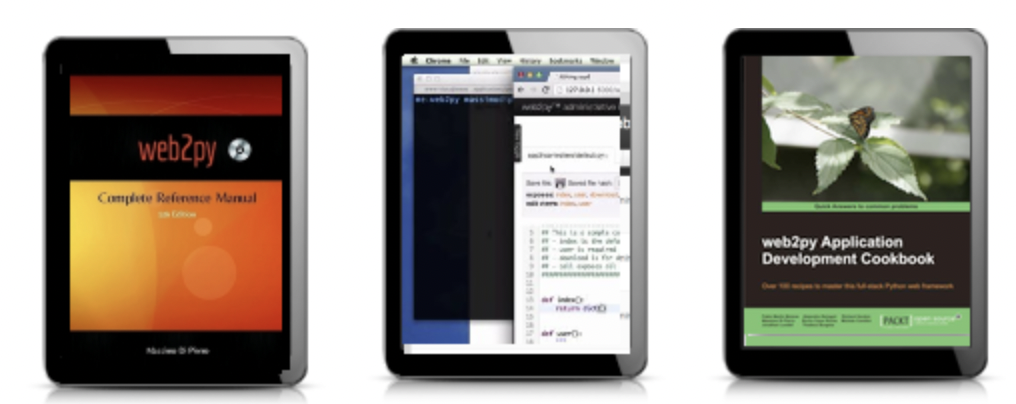
Source: Web2Py
Features of Web2Py
- Web2Py offers role-based access control to prevent data misuse.
- Built-in data protection to keep your web applications safe.
- MVC architecture support simplifying web development.
- Web-based IDE accelerates web development projects like cleaning temp files, editing app files, browsing past tickets, and running tests.
Advantages of Web2Py
- WebPy allows developers to work with broadly used relational and NoSQL databases.
- The framework offers useful features to build a variety of web apps without the need for external tools and services.
- The flexible nature of Web2Py makes it suitable for both simple and large-scale projects.
- Web2Py has an active community to support you all the time.
Disadvantages of Web2Py
- The plugin system of Web2Py is not flexible.
- You may face difficulty managing the procedure for loading data models in Web2Py.
6. TurboGears
TurboGears is a data-driven Python framework for full-stack web application development. It empowers software developers to use various JavaScript tools to streamline web development. With this Python framework, you can start developing web applications almost immediately.
The TurboGears framework is suitable if you need a database connection for developing a web application.
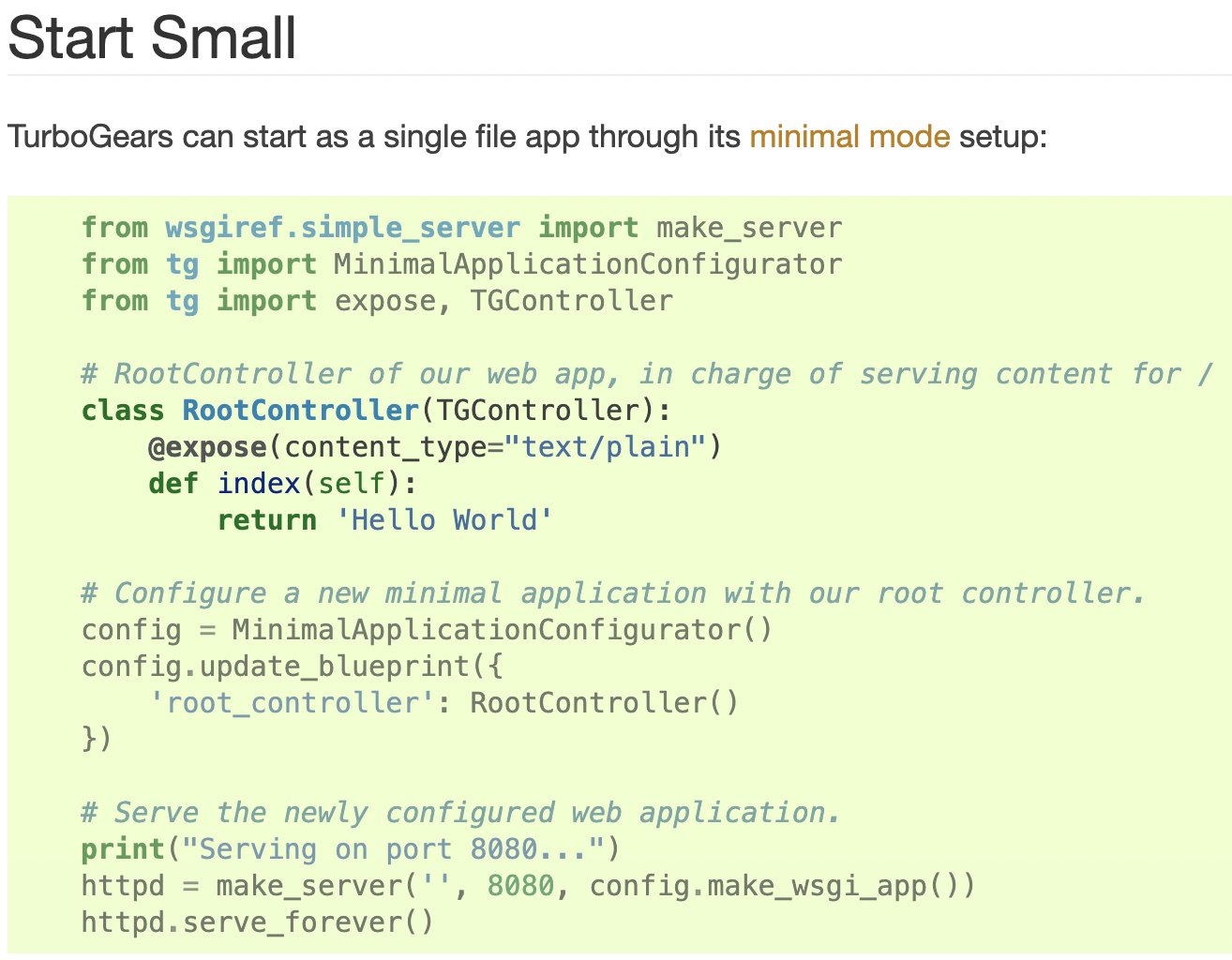
Source: TurboGears
Features of TurboGears
- Support for tools like SQLAlchemy, Repoze, WebOb, and Genshi for faster web application development.
- Accessible command-line tools and multi-database support.
- MVC-style architecture and PasteScript templates.
- Multi-database support.
- You can use ToscaWidgets to simplify the coordination of frontend design and server deployment.
Advantages of TurboGears
- You can create plugin modules or modify existing ones with TurboGears.
- Since TurboGears is flexible, you can start with a simple project and eventually scale it as you advance.
Disadvantages of TurboGears
- TurboGears lacks extensive documentation. It means finding even a simple solution; you must dig deep.
- The learning curve in TurboGears is steep, and you would have to practice it a lot before starting to use it.
7. Tornado
Tornado is an asynchronous framework and network library for Python web application development. It uses a non-blocking framework I/O and can handle 10,000+ simultaneous connections.
Turbo is an ideal choice for building web applications that need control over asynchronous networking. It also excels at building apps that query other sites in parallel and act on the returned data.
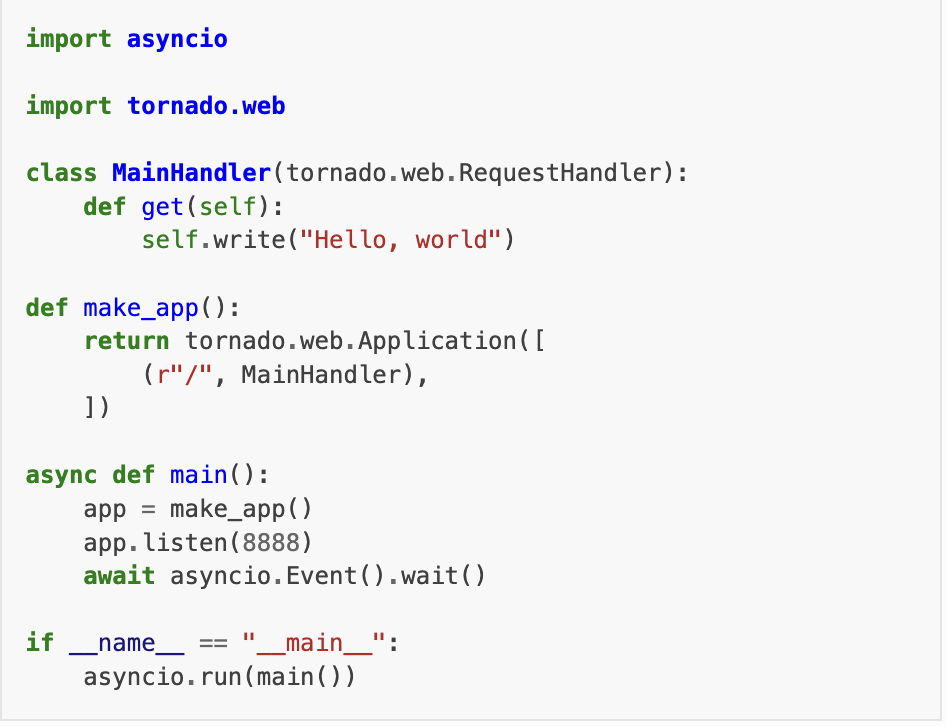
Source: Tornado
Features of Tornado
- Python-based web templating language
- Implementation of third-party authentication and authorization schemes like Google OpenID/OAuth and Twitter OAuth
- Support for localization and translation
- User authentication support
Upsides of Tornado
- Tornado offers superior quality, real-time services – resulting in high performance.
- Since Tornado is simple and lightweight, you can quickly get along.
Downsides of Tornado
- Tornado has many third-party module options for the template and database, which may not be conducive to packaging as a functional module.
Python Frameworks Enable Strong Development Work
There is no definite answer to which Python web framework is the best for web development. Each framework has its positive and negative sides, and your decision only depends on what type of app you want to develop.
Always be careful while choosing the framework. A wrong choice can result in heavy losses and weeks of wasted effort. Which of the Python frameworks mentioned above do you prefer? Please share in the comments.
